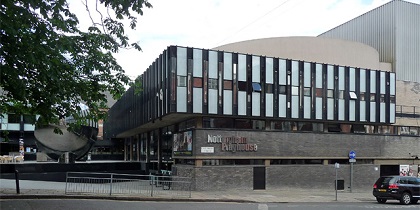
January 22, 2019, by Sunita Tailor
The Madness of George III at the Nottingham Playhouse
This blog was written by final year English student, Jade Braham.
Under Adam Penford’s ingenious direction Alan Bennett’s masterpiece The Madness of George III finally hit the Nottingham Playhouse’s stage. Set in 1788, it follows the journey of the king who, having reigned from 1760, finds his life and the Nation’s stability threatened by his unexpected descent into madness. With its elaborate set design and extraordinary Olivier Award-winning cast, with Mark Gatiss as the lead, the production foregrounded questions surrounding power and identity.
It is rare to have the atmosphere of the play transpire into the auditorium before its onset but Designer Robert Jones has outdone himself. By transforming the stage curtain to a lavish gold and purple replica of an embellished cloth or fabric spoke loudly of the Royal Court’s opulence. The decision to paint this, as opposed to acquiring coloured fabric, gave the allusion of reality, of 3D. It wasn’t until much later on when the King announced “I’ve always been myself, even when I was ill. Only now I seem myself. And that’s the important thing.” did I realise the curtain’s part in spearheading the plays theme of appearance vs. reality.
In conjunction, sound designer Tom Gibbons’ meticulous use of music, brought the King’s regality to each individual in the audience. The inclusion of the King’s favourite composer George Handel, the loud sound effects of crowds cheering and religious, almost overpowering, operatic-sounding choral songs made his entrances and exits dramatically prominent. Similarly, Wardrobe Supervisor, Poppy Hall’s attention to history brought the image of 1788 to life. The pristine outfits of the King’s staff to the excessive and powerful clothing adorned by the monarchy contrasted the simplicity and increasingly dirty looking clothes and nightgown worn by the mad King.
Alongside the King’s costume was Mark Gatiss’ outstanding performance. His characterisation of the King’s transformation into madness was truthful to the extent of it becoming uncomfortable and emotionally painful to watch. The attention to his physicality and body language was astonishing – the walking on the instep of the left foot created a limp and lopsided stance whilst his raised but limp left arm hinted at his inability to control anything. It became even more heart-breaking when wheeled onto stage, the once tall, perfect postured king, was curled into a ball with his knees tucked into his abdomen and his shoulder hunched forward, causing his head to droop.
The production was a knockout success. I found myself crying and laughing simultaneously, wishing I could re-watch it.
No comments yet, fill out a comment to be the first

Leave a Reply